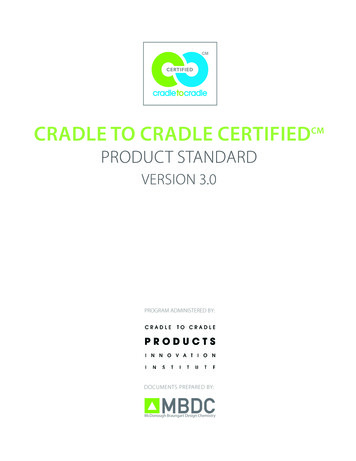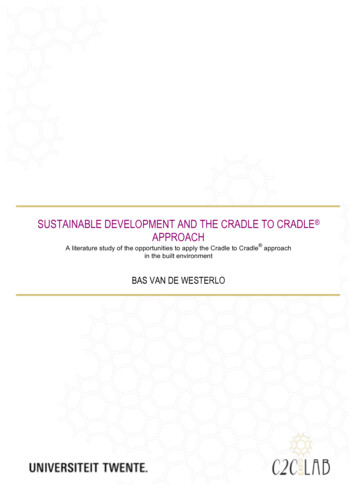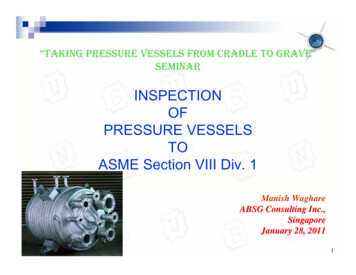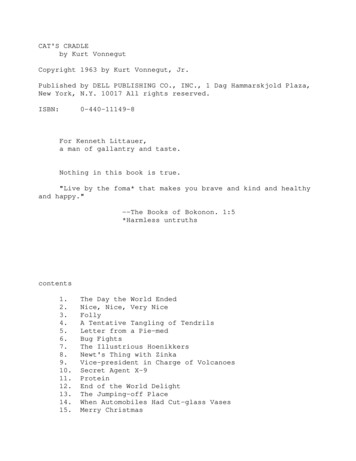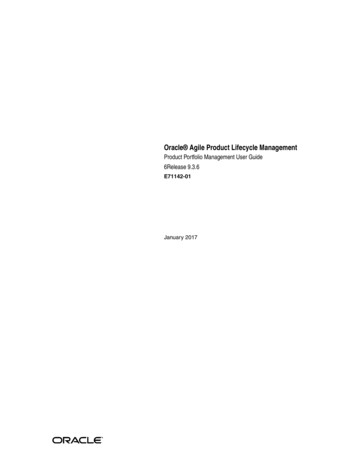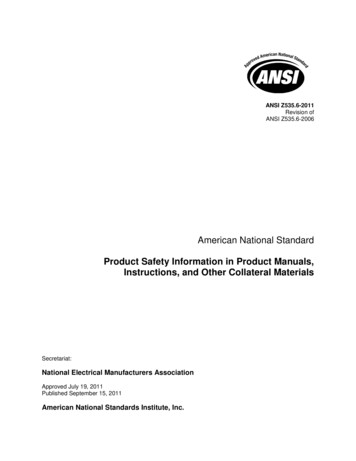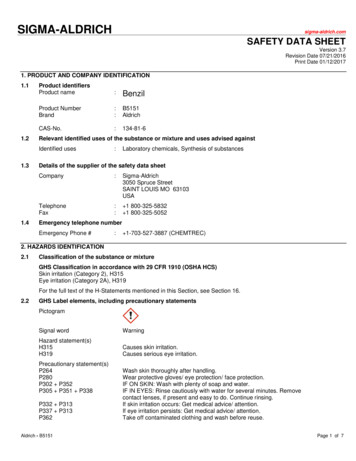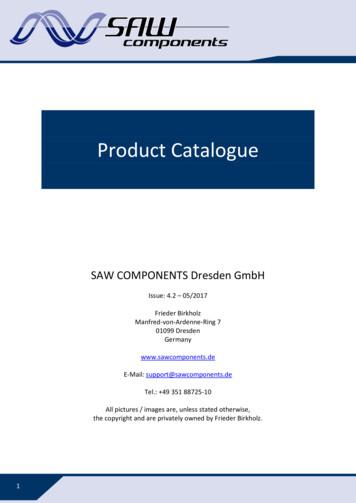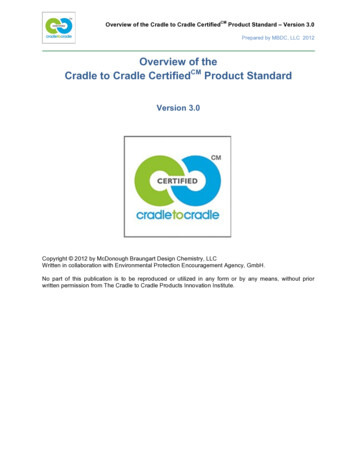
Transcription
Overview of the Cradle to Cradle CertifiedCMProduct Standard – Version 3.0Prepared by MBDC, LLC 2012Overview of theCradle to Cradle CertifiedCM Product StandardVersion 3.0Copyright 2012 by McDonough Braungart Design Chemistry, LLCWritten in collaboration with Environmental Protection Encouragement Agency, GmbH.No part of this publication is to be reproduced or utilized in any form or by any means, without priorwritten permission from The Cradle to Cradle Products Innovation Institute.
Overview of the Cradle to Cradle CertifiedCMProduct Standard – Version 3.0Prepared by MBDC, LLC 2012CONTENTSForward . iiiSupporting Documents . iv1Introduction to Cradle to Cradle . 11.1What is Cradle to Cradle Design? . 21.2The Cradle to Cradle Principles . 31.3Complementary Metabolisms . 41.3.1Effective Material Cycles . 52Overview of the Standard . 72.1Product Scope . 72.2Standard Categories and Their Scope . 72.3Certification Levels . 82.4Continuous Improvement and Optimization . 92.5Certification Marks . 103Material Health . 113.1Banned Lists of Chemicals . 123.2Figure Summarizing the Material Health ABC-X Assessment Process . 194Material Reutilization . 205Renewable Energy and Carbon Management . 216Water Stewardship . 227Social Fairness . 238References . 24
Overview of the Cradle to Cradle CertifiedCMProduct Standard – Version 3.0Prepared by MBDC, LLC 2012ForwardCMThis document provides an overview of the Cradle to Cradle Certified Product Standard (VersionCM3.0). The Cradle to Cradle Certified Product Standard (Version 3.0) replaces Version 2.1.1. TheCradle to Cradle Products Innovation Institute will begin certifying products using Version 3.0 of theStandard on January 1, 2013.Suggestions for improvement of this standard should be directed to The Cradle to Cradle ProductsInnovation Institute , which took over the administration of the seven-year-old Cradle to CradleCMCertified Product Program in 2012.The Cradle to Cradle Products Innovation Institute CMThe Cradle to Cradle Products Innovation Institute administers the Cradle to Cradle Certified ProductsProgram. The Cradle to Cradle Certification Standards Board, using the Cradle to Cradle framework, isCMresponsible for reviewing and approving revisions and/or amendments to the Cradle to Cradle CertifiedProduct Standard and ensuring continuous improvement of products based upon five attributes: materialhealth, material reutilization, renewable energy and carbon management, water stewardship, and socialfairness. Products that meet the transparent criteria of this rating system will receive the Cradle to CradleCMCertified certification mark for one of five levels. (http://c2ccertified.org)McDonough Braungart Design Chemistry, LLCSince 1995, MBDC has been consulting with clients to integrate the Cradle to Cradle framework andoptimize products, operations, and organizational culture. MBDC is an Accredited Assessor for the CradleCMto Cradle Certified Product Program. (http://mbdc.com)Environmental Protection Encouragement Agency, GmbHFounded by Professor Dr. Michael Braungart in 1987, the Environmental Protection EncouragementAgency (EPEA) Internationale Umweltforschung GmbH, works with clients worldwide to apply the Cradleto Cradle methodology to the design of new processes, products and services. Materials are appliedwith respect for their intrinsic value and their useful afterlife in recycled or even "upcycled" products,which have value and technological sophistication that may be higher than that of their original use. EPEACMis an Accredited Assessor for the Cradle to Cradle CertifiedProduct Program. (http://epeahamburg.org) Together, we take on the challenge of scientifically evaluating and innovatively designingproducts according to a unique design practice. Cradle to Cradle and C2C are trademarks of MBDC, LLCiii
Overview of the Cradle to Cradle CertifiedCMProduct Standard – Version 3.0Prepared by MBDC, LLC 2012Supporting DocumentsThe following documents are to be used in conjunction with the Cradle to Cradle CertifiedStandard: CMProductCMCradle to Cradle Certified Product Standard, Version 3.0.CMCradle to Cradle Certified Product Material Health Assessment Methodology, Version 3.0.CMCradle to Cradle Certified Policies and Procedures.All supporting documents can be downloaded from the Cradle to Cradle Products Innovation Institutewebsite (http://c2ccertified.org).Cradle to Cradle and C2C are trademarks of MBDC, LLCiv
Overview of the Cradle to Cradle CertifiedCMProduct Standard – Version 3.0Prepared by MBDC, LLC 20121Introduction to Cradle to Cradle Cradle to Cradle was developed by Michael Braungart and William McDonough, two pioneers mergingintentional design, chemistry, and products for industry. Originally used loosely as a term with different(1)meanings as contraindication to “cradle to grave,” Cradle to Cradle is a beneficial design approachintegrating multiple attributes, including safe materials, continuous reclamation and re-use of materials,clean water, renewable energy, and social fairness.Michael Braungart formed the Environmental Protection and Encouragement Agency (EPEA)(2)Internationale Umweltforschung GmbH in 1987, and soon afterward launched the Intelligent ProductsSystem (IPS), which defined materials as nutrients with the unique characterization that such materialscould be continually reused in biological and technical cycles. The IPS was based on the Europeanprecautionary principle and brought a new perspective: that materials can be seen as key parts oftechnical and biological metabolisms.At the same time, William McDonough was working as an architect in New York pioneering approaches tobuilding design and concepts—such as “a building like a tree, a city like a forest”—which becamefoundational to the green building movement. His projects included building the first green office in NewYork for the Environmental Defense Fund in 1984, a solar-powered daycare center operated by children(1989), and a strategy for carbon balance and offset that garnered front-page coverage in the Wall StreetJournal—three years before the Rio Earth Summit. He was a founding member of the American Instituteof Architects Committee on the Environment (COTE) and a charter member of the United States GreenBuilding Council (USGBC).Braungart and McDonough met in 1991 and began to share ideas. Together they merged the concept ofmaterials as nutrients within biological and technical cycles and the concept of intentional design. Thislater would become the Cradle to Cradle design framework, which presents all of human creation withinbiological/technical cycles, continuous reuse, renewable power, and clean water—all celebrated as ahuman right.At the suggestion of Braungart, McDonough was commissioned in 1992 by the city of Hannover,Germany to prepare the design principles for EXPO 2000, the World’s Fair. The Hannover Principles –(3)Design for Sustainability were received and honored by Jaime Lerner, mayor of Curitiba, at the WorldUrban Forum of the Rio Earth Summit (UNCED) in 1992. They were delivered as a gift from the state ofLower Saxony by McDonough, who attended as a representative of the American Institute of Architectsand the International Institute of Architects. In 1995, Braungart and McDonough co-founded McDonough(4)Braungart Design Chemistry, LLC (MBDC).The Atlantic magazine published an article by McDonough and Braungart entitled “The Next Industrial(5)Revolution” in October 1998. This article chronicled the rise of “eco-efficiency” (doing more with less) asthe main environmental strategy of many leading businesses and introduced the idea of “ecoeffectiveness” to determine the right thing to do before doing it efficiently. In this article theterms “downcycling” and “upcycling” were introduced to show how, by design, we can return productmaterials with improved, rather than degraded quality over time.By 2001 several case studies on the integration of the Cradle to Cradle design principles in product(6)design by leading businesses were made available in video and DVD form by Earthome Productions.Included in this compilation were stories from Designtex (Steelcase), Herman Miller, Ford and Nike. In(7)2002, the book “Cradle to Cradle – Remaking The Way We Make Things” was published.CM(8)MBDC launched the Cradle to Cradle Certified Program in October 2005. As the program hasgrown worldwide, the desire for an independent review and issuance of certificates was identified to bringthe program into the global mainstream. In August 2010 an exclusive, worldwide license was granted toCradle to Cradle and C2C are trademarks of MBDC, LLC1
Overview of the Cradle to Cradle CertifiedCMProduct Standard – Version 3.0Prepared by MBDC, LLC 2012the Cradle to Cradle Product Innovation Institutethe certification program. (9)as a third party not-for-profit organization to manage Note: Cradle to Cradle , C2C and are registered marks of McDonough Braungart Design Chemistry, LLC.CMCMCertified Cradle to Cradle , Cradle to Cradle Certified, and are registered marks of McDonough Braungart DesignChemistry, LLC used under license by the Cradle to Cradle Products Innovation Institute.1.1What is Cradle to Cradle Design? The Cradle to Cradle design principles provide a positive agenda for continuous innovation around theeconomic, environmental, and social issues of human design and use of products and services.Specifically, the purpose of the product certification program is to improve the way we make, use, and reuse things recognizing two metabolisms, the biological metabolism and the technical metabolism, with agoal to leave a beneficial footprint for human society and the environment.The aim is to set a positive course for product and process design and development in a way that willallow natural and technical systems, products, and processes to support the diverse living population onearth. Cradle to Cradle design mirrors the healthy, regenerative productivity of nature, and considersmaterials as assets, not liabilities.Management theorist Peter Drucker has said that it is a manager’s job to do something the right way – tobe efficient – but it is an executive’s job to do the right thing – to be effective. To date, global efforts bybusinesses have been focused on becoming more efficient and reducing the (bad) environmental“footprint” by optimizing existing systems, which may be wrong designs. Cradle to Cradle design is aboutchoosing the right thing to do and then doing that thing the right way to achieve positive outcomes. Inother words, to become “more good” not just “less bad.”For example, while it makes sense to slow down the use of fossil fuels, this is not the goal. Cradle toCradle is a continuous improvement process design tool that starts with the positive or beneficial end inmind and executes efficiently towards achieving this goal. In this example the Cradle to Cradle goal is amove to renewable energy sources.Long-Term Goals - Short-Term Actions and TransitionsWe start by defining long-term Cradle to Cradle goals and then develop transitional strategies to achievethem. In the short term, we can make successive design-based decisions that will move us to a moresustaining condition. The short-term actions for product development start with complete identification ofthe materials and chemicals that make up the product and process in order to assess them for humanand ecological impacts.In the medium term the goal is for designs that are positive or beneficial in terms of cost, performance,aesthetics, material health, and material (re)utilization potential with continuous use and reuse periods.Additionally, moving renewable energy forward in a cost-effective way, celebrating clean water as ahuman right, and honoring social systems are part of the holistic Cradle to Cradle approach.Cradle to Cradle and C2C are trademarks of MBDC, LLC2
Overview of the Cradle to Cradle CertifiedCMProduct Standard – Version 3.0Prepared by MBDC, LLC 2012The long-term goals can be wholly positive and intended to support 10 billion people and other species.For example, McDonough and Braungart’s long-term goal is:“Our goal is a delightfully diverse, safe, healthy and just world, with clean air, water, soil andpower - economically, equitably, ecologically and elegantly enjoyed.”Cradle to Cradle provides a unique frame of thinking that is based on the precautionary principle andtrust in the product supply chain. This is not a framework based on guilt or intended as an opportunity fortaking legal actions. Rather it is the basis for building up a support system.We work with humility and recognize that checking single chemicals in materials and products does notgive the complete picture and that there may be unintended consequences, but it is a good start. Infocusing attention on chemicals it is not our intention to promote more animal testing. If a chemical bioaccumulates we would rather see alternatives substituted.The question becomes one of design intention and we can ask, “what type of products do we want tosee?” Chemists become designers and designers become chemists. As humans, we accept thelimitations of our knowledge and we will make mistakes, but these mistakes need to be reversible byfuture generations.The product certification program is a QUALITY statement using QUANTITY indicators. Each levelrepresents a higher quality indicator using multiple attributes. Today the program is primarily orientedfrom a Western cultural perspective. Longer term, the program is expected to evolve and qualityindicators respecting and celebrating cultural diversity are anticipated.1.2The Cradle to Cradle PrinciplesIn nature, there is no concept of waste. Everything is effectively food for another organism or system.Materials are reutilized in safe cycles. There are no persistent, bio-accumulative materials that can lead toirreversible changes. The earth accrues biota grown from the energy of the sun. We celebrate thediversity of people and of species. We become native to place, celebrating abundance and honoringevery child that is born. In short, the design of goods and provision of services can be achieved with threeprinciples in mind:1. Eliminate the Concept of Waste Nutrients become nutrients again. All materials are seen as potential nutrients in one of twocycles – technical and biological cycles.Design materials and products that are effectively “food” for other systems. This means designingmaterials and products to be used over and over in either technical or biological systems.Design materials and products that are safe. Design materials and products whose nutrientmanagement system leaves a beneficial legacy economically, environmentally and equitably.Create and participate in systems to collect and recover the value of these materials andproducts. This is especially important for the effective management of scarce materials.Clean water is vital for humans and all other organisms. Manage influent and effluent waterstreams responsibly, and consider local impacts of water use to promote healthy watersheds andecosystems.Carbon dioxide (CO2) should be sequestered in soil. Our current practice where carbon dioxideends up in the oceans and in the atmosphere is a mismanagement of a material.Cradle to Cradle and C2C are trademarks of MBDC, LLC3
Overview of the Cradle to Cradle CertifiedCMProduct Standard – Version 3.0Prepared by MBDC, LLC 20122. Use Renewable Energy The quality of energy matters. Energy from renewable sources is paramount to effective design.Aligning with Green-e’s list of eligible sources, renewable energy sources are solar, wind,hydropower, biomass (when not in competition with food supplies), geothermal, and hydrogenfuel cells.3. Celebrate Diversity Use social fairness to guide a company's operations and stakeholder relationships.Encourage staff participation in creative design and research projects to enhance your Cradle toCradle story.Technological diversity is key for innovation; explore different options in looking for creativesolutions.Support local biodiversity to help your local ecosystem flourish; strive to have a beneficial social,cultural and ecological footprint.Under the Cradle to Cradle design approach, products that result in materials flowing into the biosphere(either from the product contents or the packaging) are considered to be “products of consumption.”Materials that are recovered after use can be considered to be “products of service.” (Note: somematerials such as paper or bio-plastics are products of consumption as they ultimately return to thebiosphere after a number of post-use cycles.)1.3Complementary MetabolismsCradle to Cradle certification focuses on the characteristics of sustainable materials, products, andsystems. As a result, this method places a major emphasis on the human and ecological health impactsof a product’s ingredients at the chemical level, as well as on the ability of that product to be truly recycledor safely composted. The quality of energy used to create a product, water quantity and quality, andsocial fairness also are essential Cradle to Cradle characteristics and focus areas in this certificationprocess.Cradle to Cradle design draws on knowledge from the fields of environmental chemistry and materialflows management (broadly termed Industrial Ecology), and the fields of industrial and architecturaldesign. It includes the Intelligent Product System (IPS) pioneered by chemist Dr. Michael Braungart in1986.Cradle to Cradle is an innovative approach that models human industry on the processes of nature’sbiological nutrient metabolism integrated with an equally effective technical nutrient metabolism, in whichthe materials of human industry safely and productively flow within the two metabolisms in a fullycharacterized and fully assessed way. Products that are designed as services are made from materialsthat cycle in the technical metabolism at the end of their use cycle. Consumption products, those thatnaturally end up in the environment (biological cycle) during or post-use, are made from materials that areinherently safe for the biosphere.Nature’s metabolism runs on renewable energy and returns all materials safely in cycles for reuse.Everything can be considered a nutrient with future value. All of our man-made designs exist in thismetabolism and many products will result in the nutrients connecting with, and flowing directly into, thissystem during and after use. These materials need to meet a standard for “biological nutrients” with thehighest level of safety designed in.Products that have achieved positive design milestones along the continuum of improvement are shownto be suitable for cycling perpetually on Earth, using ingredients that are safe and beneficial – either tobiodegrade naturally and restore the soil, or to be fully recycled into high-quality materials for subsequentCradle to Cradle and C2C are trademarks of MBDC, LLC4
Overview of the Cradle to Cradle CertifiedCMProduct Standard – Version 3.0Prepared by MBDC, LLC 2012product generations, again and again. This allows a company to eliminate the concept of waste andrecover value, rather than creating a future of solid waste liability. Cradle to Cradle design turnscontingent liabilities into assets.Depiction of Biological and Technological Nutrient Cycles1.3.1 Effective Material Cycles1.3.1.1 Products of ConsumptionA product of consumption is a material or product that is typically changed biologically, chemically, orphysically during use and therefore enters the biosphere either by nature or by human intention. As aresult, products of consumption should consist of biological nutrient materials.Biological cycle materials and products need to be designed for safe combustion without the need forfilters. Biological cycle products such as paper or bio-plastics may go through a series of technical cycles(e.g., recycling) before finally going safely into biological systems (e.g., composting or incineration forenergy recovery).A biological nutrient product is usable by defined living organisms to carry on life processes such asgrowth, cell division, synthesis of carbohydrates, energy management and other complex functions. Anymaterial emanating from a product of consumption that comes into intentional or likely unintentional anduncontrolled contact with biological systems is assessed for its capacity to support their metabolism.Metabolic pathways consist of oxidation, catabolism (degradation, decrease in complexity), andanabolism (construction, increase in complexity), both occurring generally in a coupled manner. Theclassification of products as biological nutrients (or source of nutrients) depends on the biological systemswith which they interact. These systems can be more or less complex along the following organizationalhierarchy: Organisms (nutrients for predators). Organic macromolecules and combinations thereof (nutrients for fungi, microorganisms, vegetariananimals; oral, dermal or olfactory nutrients). Minerals (nutrients for autotrophic plants).Cradle to Cradle and C2C are trademarks of MBDC, LLC5
Overview of the Cradle to Cradle CertifiedCMProduct Standard – Version 3.0Prepared by MBDC, LLC 2012For example, a detergent that is comprised of readily biodegradable materials could be designed suchthat the material or its breakdown products provide nutrition for living systems. Products like tires andbrake shoes that abrade in use are also products of consumption, but have yet to be designed withbiological nutrient materials.1.3.1.2 Products of ServiceA product of service is a material or product designed to provide a service to the user without conveyingownership of the materials. Products of service are ideally comprised of technical nutrients that arerecovered at the end-of use-phase.Technical nutrients (TNs) are products or materials that “feed” technical systems. While they may or maynot be suitable to return to air, soil, or water, technical nutrients are never consumed but instead arecatabolized (deconstructed) and anabolized (constructed) according to the following hierarchy: (Dismantle and) reuse. (Dismantle and) physical transformation (e.g., plastic remolding). (Dismantle and) chemical transformation (e.g., plastic depolymerization, pyrolysis, gasification).Technical nutrients can therefore be managed with service contracts or leasing models so that usersbenefit from the product service without owning the materials. In the case of scarce materials, it isespecially important to use them in products of service so that they remain available over the long-termas useful materials.1.3.1.3 Externally Managed Components (EMCs)An EMC is a sub-assembly, component, or material within a product that is exempt from the generalrequirement of full characterization to the 100 ppm level because it is managed in a technical nutrientcycle as part of a supplier or manufacturer commercialized nutrient management program.To be considered an EMC, the sub-assembly, component, or material within a product must meet thefollowing criteria:i.The supplier of the EMC has provided the applicant with a guarantee for take back and appropriatenutrient management. The supplier may designate a third party or parties for implementation.ii.The supplier has signed a declaration that chemicals in the EMC will not negatively impact humans orthe natural environment during the intended and unintended but highly likely use of the product forwhich the EMC is a component. This guarantee may be provided via a Cradle to Cradle certification(Gold level or higher) of the EMC, or other appropriate evidence.iii.The EMC has undergone testing by an accredited analytical laboratory to ensure that harmfulsubstances are not being emitted from the EMC above the chemical’s analytical detection limits. Offgas testing is required for all EMCs (See Section 3.9 for more information on volatile organiccompounds [VOCs] emission testing). Migration and leaching testing may be required depending onthe type of EMC.Note that EMCs are not exempt from banned list declarations. Also note that if during use of the productfor which the EMC is a component a user is exposed to any part or chemical within the component, or ifany part or chemical within the component is released to the environment, the component is notconsidered an EMC and will be assessed and inventoried like the other materials in the product.CMEMCs were introduced in version 3.0 of the Cradle to Cradle Certified Product Standard as a way toinclude product components that do not need to be assessed the same way as the rest of a productbecause they are managed as a whole by the supplier or a third party. The EMC concept was invented bythe founders of the Cradle to Cradle framework to encourage manufacturers to design complexCradle to Cradle and C2C are trademarks of MBDC, LLC6
Overview of the Cradle to Cradle CertifiedCMProduct Standard – Version 3.0Prepared by MBDC, LLC 2012components that are completely managed after their use phase. As of the release date of version 3.0 ofCMthis Standard, an EMC had not yet been included in a Cradle to Cradle Certified product. Examples ofpotential EMCs are a pneumatic cylinder in an office chair, the motherboard in a computer, the electricmotor inside an automated window shade product, and a solar panel.2 Overview of the Standard2.1Product ScopeThis certification program applies to materials, sub-assemblies, and finished products. Materials and subassemblies can be considered “products” for certification purposes.This program does not address performance measures associated with any products that qualify forCradle to Cradle certification. Product compliance with all applicable laws and regulations is assumed.Some rules in the program address activities that are also subject to regulation by local, state, or federalauthorities. However, nothing contained herein changes legal regulatory requirements or prescribes howcompliance is to be achieved. Documentation of compliance with certain key regulations may be includedin some sections of the Standard, but this in no way changes the underlying regulatory requirements.There are a number of product attributes that may exclude a manufacturer from seeking certification. Thefollowing list depicts some cases and issues that are out of the scope of this program. The purpose of thislist is to create a threshold to prevent unreasonable products from entering the system and to protect thepositive values around products, as well as their usefulness. The scope of the program does not includethe following:CM The presence of any chemicals from the Cradle to Cradle Certifiedfor lists). Processes in and of themselves. Food or beverages. Buildings, countries, cities. Products from rare or endangered species (e.g., ivory). Products with ethical issues (e.g., weapons, tobacco, electric chair, etc.). Products leading to or including animal abuse. Products with apparent safety concerns related to physical and chemical characteristics. Companies involved in rain forest damage, child labor, blood metals, or blood diamonds. Applicant involved in terror support, racism/discrimination, or weapon production or connection. Nuclear power and/or products used to produce nuclear power. Products that may be contrary to the intent of the Cradle to Cradle principles.2.2“Banned List” (See AppendixStandard Categories and Their ScopeProducts seeking Cradle to Cradle Certification are evaluated against criteria in the following fivecategories:Material Health – The ultimate goal is for all products to be manufactured using only those materials thathave been optimized and do not contain any X or Grey assessed materials/chemicals. As such, pro
Cradle is a continuous improvement process design tool that starts with the positive or beneficial end in mind and executes efficiently towards achieving this goal. In this example the Cradle to Cradle goal i
